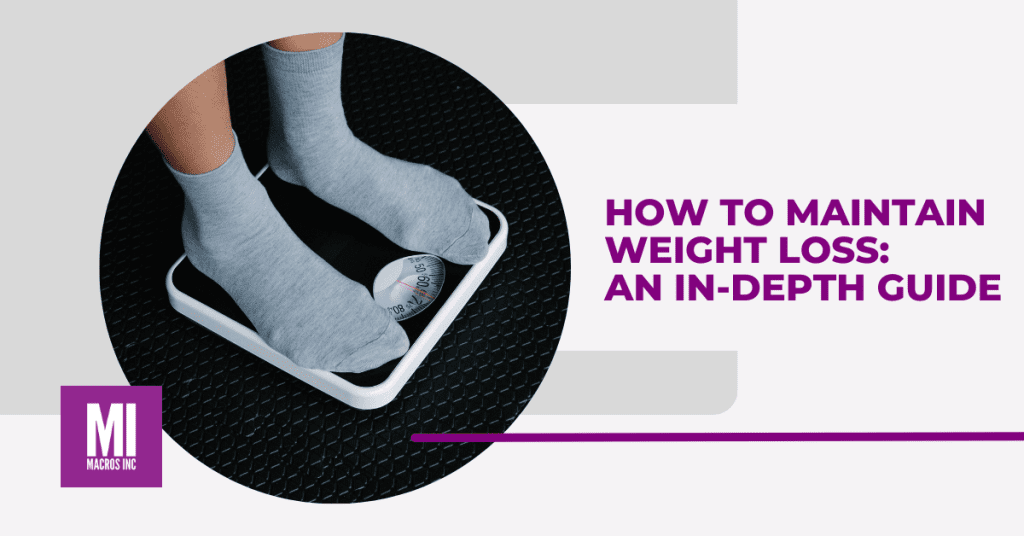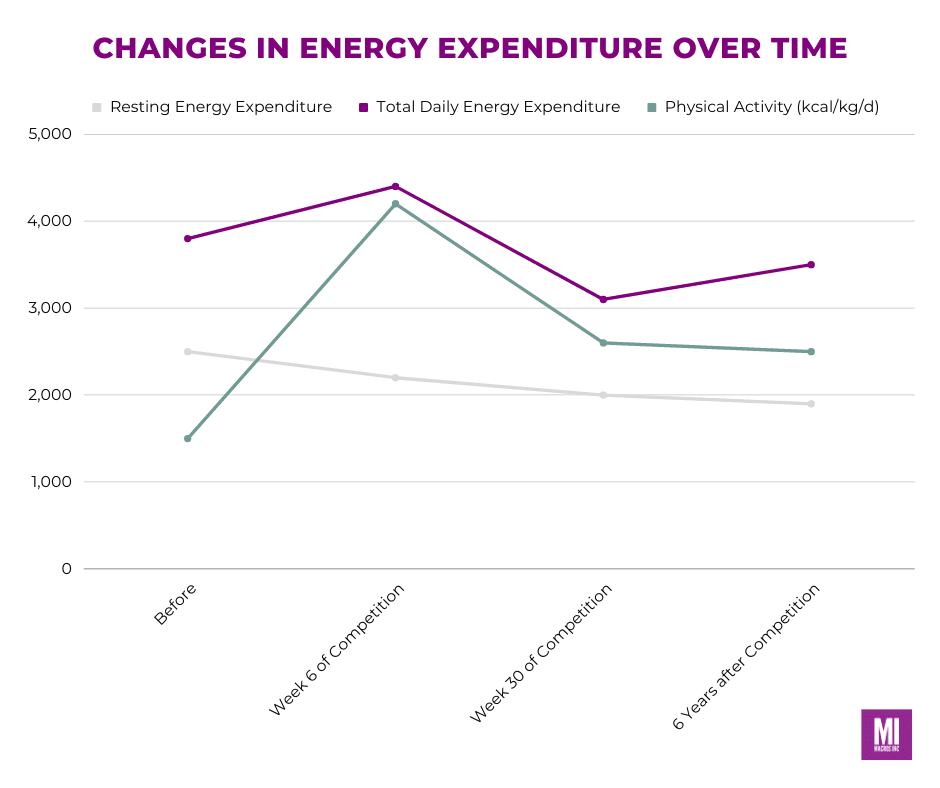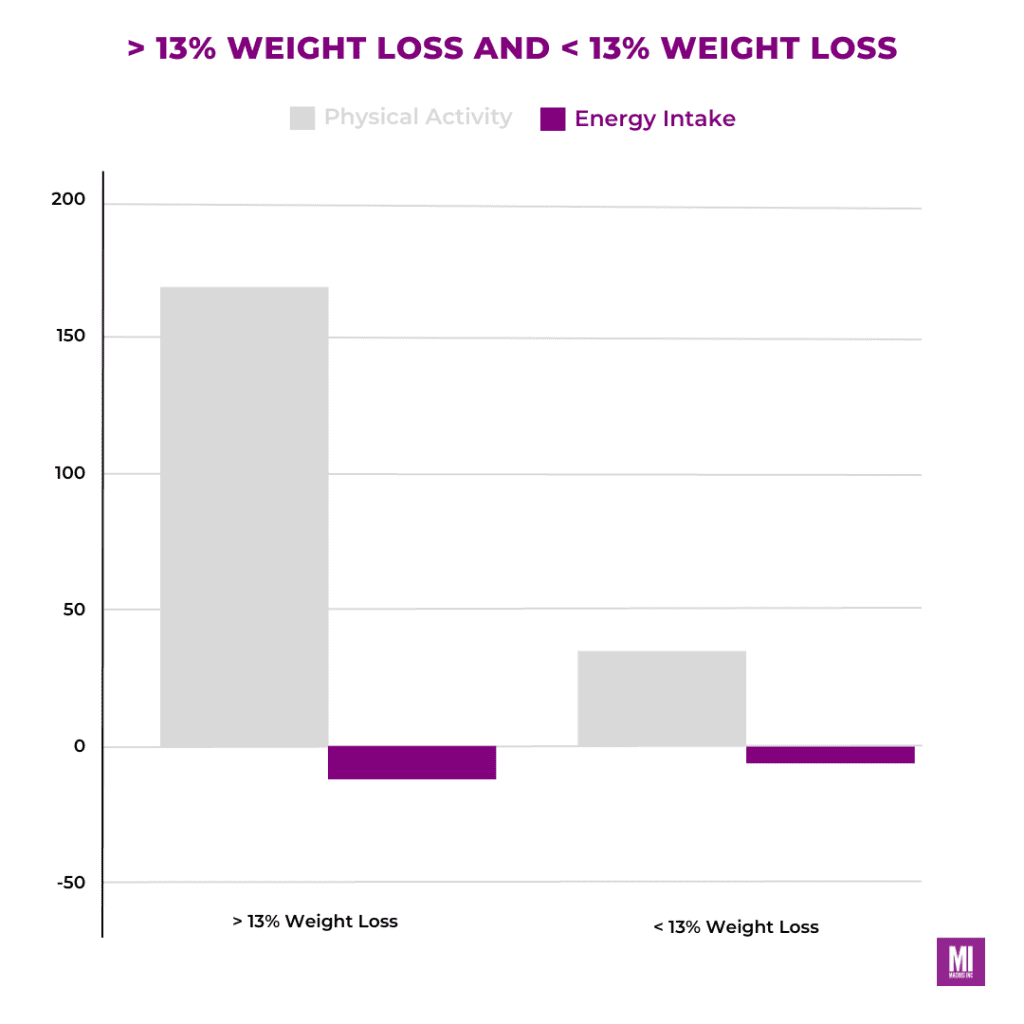How to maintain weight loss: An in-depth guide

HOW TO MAINTAIN WEIGHT LOSS
“What will I do after I reach my weight loss goal?”
This is one of the most important questions that people need to ask themselves as they start their weight loss journey because at some point, you will have a “life after weight loss,” and having the skills, tools, and mindset to live in maintenance is crucial.
In this in-depth guide, we will explore the transition from weight loss to maintenance and help you build a toolbox and mindset to navigate life during the maintenance phase. This series will cover various topics that are essential for successful weight maintenance, providing you with the knowledge and strategies to sustain your progress and maintain your weight loss for good!
For a handy PDF copy of our weight maintenance guide, download our Maintenance Made Simple ebook today!
Transitioning From weight loss to maintenance
Once you have achieved your weight loss goal, it’s important to approach the transition to maintenance with a thoughtful strategy. One of the key decisions you’ll need to make is how quickly to reverse back to maintenance.
There are two main philosophies for this transition:
a) Instantly
Some individuals choose to go from a calorie deficit to true maintenance immediately. By doing so, they can experience several benefits. Instantly transitioning to maintenance can lead to increased energy levels, improved sleep, a fuller physical appearance (especially in muscles), and a faster return to normal hormonal balance.
The only potential downside of an instant transition is the possibility of gaining around 1-2 pounds while figuring out the right maintenance calorie level. However, this approach can be particularly suitable for athletes or individuals who are comfortable with rapid changes on the scale.
b) Slowly
Alternatively, some people prefer a slower approach to transitioning from weight loss to maintenance. This method involves gradually increasing calorie intake over weeks to months. Although the benefits are similar to the instant transition, they may take longer to manifest. The advantage of a slower approach is the reduced likelihood of overshooting maintenance and gaining excess weight.
The choice between these two paths depends on your personal context, goals, and preferences. Athletes might lean towards an instant transition, while individuals with a history of dieting and sensitivity to quick scale changes may find a slower transition more suitable. Remember, both approaches can be effective—it’s about finding what works best for you.
How to maintain weight loss
Preventing Weight Regain
“What often gets you somewhere isn’t necessarily what keeps you there.”
This statement holds significant relevance when it comes to weight loss and the maintenance of weight loss, specifically in preventing weight regain. While reducing calorie intake and increasing physical activity are commonly emphasized during weight loss, the dynamics shift when it comes to weight maintenance.
In weight loss, the primary drivers are typically the ability to lower food intake from current levels and increase physical activity. For most individuals, reducing calorie intake alone is sufficient to initiate substantial weight loss. However, when it comes to weight maintenance, a different aspect becomes increasingly crucial—your non-exercise activity thermogenesis (NEAT), which represents the energy expended outside of structured exercise.
The Role of NEAT in Weight Maintenance
To understand the importance of NEAT in weight maintenance, let’s explore the findings from studies conducted on participants from the television show, “The Biggest Loser.” These studies followed the show’s contestants for years after the competition, aiming to identify factors contributing to weight regain.
Among the participants, the most significant difference between those who successfully maintained their weight loss and those who experienced weight regain was their physical activity level.

The top chart shows resting and physical activity related energy expenditure during and after the Biggest Loser show. The bottom graph shows people who did or did not regain most of their weight loss and the difference in energy intake (food) and energy expenditure between the two groups.

The Impact of Physical Activity on Maintenance Habits
Research findings consistently revealed that sustained weight loss maintenance was heavily reliant on maintaining a higher level of physical activity, particularly NEAT. Despite most participants sustaining a lower calorie intake, those who did not maintain increased physical activity were significantly less likely to remain at true maintenance levels.
While dieting plays an integral role in weight loss, your physical activity is a critical component for establishing habits that support weight loss maintenance—commonly referred to as maintenance habits.
Maintaining Weight Loss: Change your timelines
One of the key principles we emphasize to our clients is the importance of mentally separating fat loss from maintenance, particularly when it comes to understanding timelines.
There are several reasons why this separation is crucial.
Different Timelines for Fat Loss and Weight Maintenance
Firstly, the timelines for fat loss and maintenance differ significantly. Fat loss is typically measured in weeks or months, where individuals focus on achieving their desired weight. However, maintenance is an ongoing journey that spans years. While the habits developed during fat loss can provide a foundation for maintenance, they alone are not enough.
Adopting a Long-Term Perspective
In learning how to maintain weight loss, it’s essential to adopt a longer horizon and establish more sustainable habits. This involves taking an honest look at your food intake and exercise routines after weight loss and recalibrating as necessary. Evaluating whether your current habits are sustainable for the long term is crucial.
For example, if you achieved a 600 calorie per day deficit during your weight loss phase, you might have achieved this by significantly reducing your food intake (let’s say to 1500 calories per day) or by engaging in extensive exercise. However, sustaining your weight loss at 1500 calories per day may not be necessary. You may find that you can maintain your weight at a higher calorie level, such as 1900 calories per day. This provides you with more food freedom, but it also requires discipline to make choices aligned with your long-term goals.
Compartmentalizing Weight Maintenance and Fat Loss
To maintain weight loss successfully, it’s beneficial to compartmentalize maintenance and fat loss in your mind as different phases that require distinct habits and timelines. Recognize that the strategies and approaches you employed during fat loss may need adjustments to align with sustainable, long-term maintenance.
By embracing this mindset shift, you can approach weight maintenance with a focus on longevity and finding a balance that works for you. It’s an opportunity to establish habits that support your overall well-being and allow for more freedom while maintaining discipline over an extended timeline.
work with a macros inc coach And take your goals to the next level
The Truth about your lowest weight
When transitioning from weight loss to maintenance, it’s important to understand that fluctuations in weight are common. These fluctuations are not necessarily indicative of body fat changes and should not be cause for alarm. Recognizing and accepting these fluctuations can help you navigate the maintenance phase more effectively.
Your Lowest Weight Isn’t Your Forever Weight
During your weight loss journey, you may have reached a point where you saw the lowest number on the scale. However, it’s important to acknowledge that this lowest weight is often artificially low. Factors such as reduced muscle glycogen and dehydration can contribute to a lower number on the scale. Understanding this concept will help you set realistic expectations during maintenance.
Recognizing the Influence of Factors on Scale Weight
When you transition to maintenance and start consuming maintenance-level calories, it’s normal to see a slight increase in scale weight.
This increase is not necessarily indicative of body fat gain. Factors such as restored hydration, replenished muscle glycogen, and fluctuations in water retention play a role in the numbers you see on the scale. It’s essential to remember that scale weight alone does not provide a complete picture of your progress.
Maintaining a Healthy Perspective
When you witness an increase in scale weight, it’s important to avoid panicking or misinterpreting the changes. Remember that weight fluctuations are normal and can be influenced by various factors. Avoid fixating solely on the scale number and instead focus on overall well-being, body composition, and other indicators of progress.
Maintaining a healthy weight is not just about the number on the scale. It involves considering various aspects of your health and well-being. Embrace a holistic approach that includes factors like body composition, energy levels, physical fitness, and mental well-being. By shifting your focus from the scale to overall wellness, you can sustain a healthier perspective during the maintenance phase.
Need some help organising your meal-prep? Download our meal-prep planner today!

Setting new goals and embracing a new path forward
Maintenance is not about “going back to your old ways”; it is about finding a new path forward. When starting any health and fitness journey, it’s crucial to shift away from the mindset of “let me get this done so I can go back to my old ways.” The old ways no longer define who we are. The goal of maintenance is to cultivate sustainable, positive habits that allow us to thrive in caloric balance, providing flexibility and freedom to live well.
Step by step guide to break bad habits
To avoid reverting back to your old ways, follow these steps to help break bad habits and embrace a new path:
1. Understand the Trigger:
Habits often have triggers or cues that lead to the behavior. Identify what triggers the habit and work to avoid or minimize those triggers. This could involve recognizing triggers associated with holidays, vacations, certain people, or specific places that prompt poor eating habits.
2. Create a Plan:
Once you have identified the habit and its triggers, develop a plan for breaking it. This plan should include specific steps you will take to avoid or replace the habit. Having a well-defined strategy increases your chances of success.
3. Set Goals:
Set realistic goals that help you stay motivated and track your progress. Ensure your goals are specific, measurable, and achievable. Having clear objectives gives you something to strive for and helps you measure your progress along the way.
4. Surround Yourself with Support:
Surround yourself with individuals who support your goals and can offer encouragement and accountability. This support network may include friends, family, or even the coaches and support group at Macros Inc. Having people who understand and cheer you on can make a significant difference in maintaining your new habits.
5. Forgive Yourself:
Breaking a bad habit and transitioning to new ways can be challenging, and setbacks may occur. It’s important to be kind to yourself and forgive any slip-ups or setbacks. Remember that progress, not perfection, is the ultimate goal. If you have a less-than-ideal day, acknowledge it, learn from it, and refocus on your goals for the next meal or day.
As you continue your maintenance journey, remember that embracing a new path forward requires leaving old habits behind. By understanding triggers, creating a plan, setting goals, seeking support, and practicing self-forgiveness, you can break free from your old ways and cultivate a healthier lifestyle.
need some inspiration for your next goal?
Setting an ideal body weight window
When it comes to setting a target weight, many of us fixate on a single number as the ultimate goal. We believe that any deviations from this number equate to failure. However, adopting such a rigid mindset sets us up for failure for several reasons.
1. Your body weight is dynamic:
It’s crucial to recognize that body weight is dynamic and constantly fluctuates. Factors unrelated to body fat mass can cause weight changes on a minute-to-minute, hour-to-hour, and day-to-day basis.
2. You may add muscle, bone, glycogen, or other lean mass that is beneficial but adds to the scale.
This has nothing to do with your fat mass again, but does add to the scale weight. Like if you lose 50 pounds and then spend 5 years working hard at maintenance you might add 3-5 pounds of muscle and bone tissue but your scale weight is up… you shouldn’t be upset about that.
Setting a Weight Window or Interval
Instead of fixating on a specific number, consider setting a target weight as a window or interval. Here’s how it works:
Let’s say your target goal weight is 145 pounds. Rather than aiming for that exact number, create an interval such as 142-150 pounds. This range allows for slight fluctuations in body weight without triggering unnecessary concern or self-judgment.
If your body weight drops below 142 pounds for more than one week, it may be an indication to consider increasing your food intake slightly. On the other hand, if your weight surpasses 150 pounds for more than one week, you could reassess your caloric intake or increase your physical activity to bring it back within the desired range. By incorporating this flexibility, you’re more likely to stay on course without overcorrecting or becoming fixated on minor weight fluctuations.
Remember, your body weight is just one measure of your overall health and progress. Focus on other markers such as body composition, energy levels, strength, and overall well-being.
How to bounce back from a bad week
During your maintenance journey, it’s important to recognize that you will inevitably experience challenging periods, whether due to lack of focus or life’s unexpected hurdles. These moments off the path are a normal part of the process.
Don’t Let Setbacks Turn into a Long-Term Struggle
The key is to ensure that those off-track days or weeks don’t transform into months or years of regression. While it’s natural to encounter extended periods when you can’t be perfect, it’s crucial to engage in damage control to minimize the impact.
Rather than succumbing to the mentality of “it’s already bad, so I’ll just let it be bad,” focus on limiting the damage. Just as one cookie during a day of dieting doesn’t mean the entire year is ruined, don’t let problems compound. Avoid getting in your own way by succumbing to negative thoughts and self-sabotaging behaviors.
Avoid Falling Victim to the Sunk-Cost Fallacy
We often observe individuals who allow a bad day to spiral into a bad decade. This behavior is rooted in our human tendency to follow feed-forward patterns, where one negative action leads to another. Changing course once we’re on this path can be challenging.
That’s why it’s vital to pay attention to your daily choices and make corrections as soon as possible. Don’t fall into the trap of the sunk cost fallacy, which convinces you to continue down an unproductive path due to past investments. Instead, accept the temporary setback, minimize its impact, and refocus on moving forward toward your goals.
Embracing Progress and Direction
Remember, even small steps in the right direction are significant. Don’t underestimate the power of making progress, no matter how small. Each step forward brings you closer to your goals, and it’s far more beneficial than taking a step in the wrong direction.
Building Sustainable Nutrition Habits for Life
At Macros Inc., our ultimate goal is to “graduate” our clients from coaching. While it would benefit us as a business for clients to stay indefinitely, our true objective is to empower them with the knowledge and tools to take control of their lives even after they leave our coaching program. A significant aspect of this empowerment involves establishing nutrition habits that can be sustained for a lifetime.
The Need for Ongoing Attention to Nutrition
While there may be periods, possibly long ones, where meticulous food tracking is not necessary, there will never be a time when you can disregard the importance of paying attention to your nutrition or working on refining your nutrition habits.
Why is this the case? It’s because sustaining nutrition habits requires continuous practice and attention. If you stop paying attention, there will inevitably be consequences, as cause and effect come into play.
The Analogy of Financial Management
To illustrate this point, consider the analogy of personal finances. Just as you always need to be mindful of your financial situation, even if you have successfully overcome debt, built savings, and have healthy cash flow, the same principle applies to nutrition. Six months of careless spending without paying attention can lead you back into a challenging financial position.
Similarly, even during the maintenance phase, you may not need to carry a food scale everywhere or meticulously measure every morsel of food you consume. However, you cannot simply do whatever you want whenever you want when it comes to your nutrition. Unfortunately, there are no hall passes for neglecting your nutrition habits.
Nutrition Advice From our blog
Summary
The journey of weight loss and maintenance is about embracing a new way of living and finding sustainable habits. As you transition into maintenance, remember it’s not a return to your old ways, but a chance to forge a new path forward.
Maintaining your weight requires a mindset shift. Set a range or window for your body weight instead of fixating on a single number. Fluctuations are normal, so don’t let them discourage you.
Expect setbacks but don’t let them derail you. Practice damage control, forgive yourself for slip-ups, and refocus on your goals. Progress is more important than perfection.
While maintenance may not require the same level of tracking, stay mindful of your nutrition. Just as you manage your finances even after getting out of debt, continue nurturing your nutritional well-being.
At Macros Inc., our goal is to empower you to take control of your life and health. We’re here to support you on your journey. Embrace the process, stay committed, and celebrate every milestone. You have the power to create a healthier and more fulfilling life.














